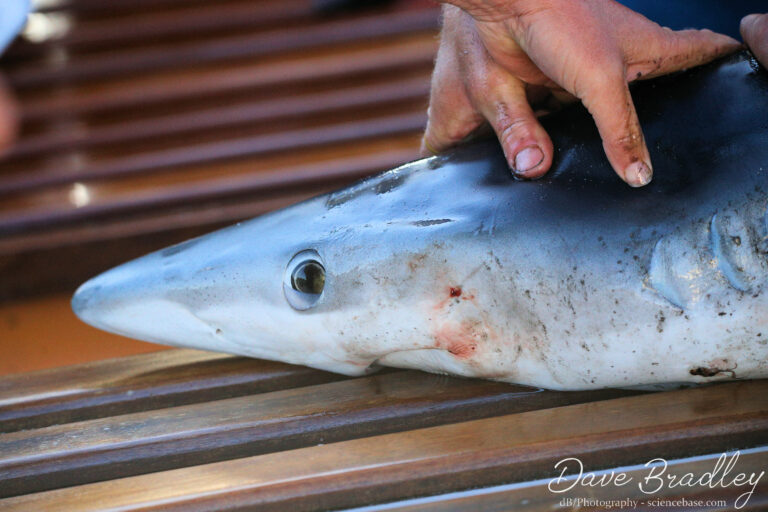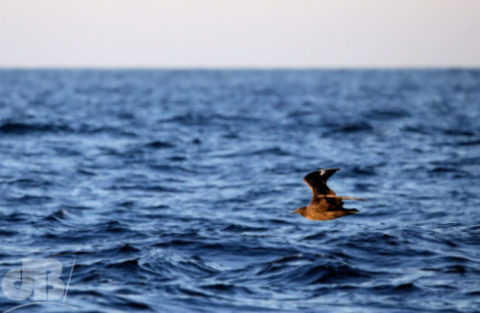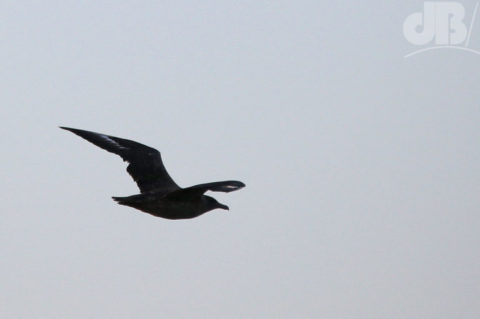We went on a pelagic trip in the Isles of Scilly with Sapphire skipper Joe Pender, departing Hugh Town harbour, St Mary’s Island on 9th July 2018 at about 5pm. Within seconds we were being tailed by dozens of Herring Gull.
Engines were cut about an hour out to sea and the anglers aboard began flicking their rods to catch mackerel, which they did, a dozen or so quite quickly. Then the fishing for Blue Shark (Prionace glauca) began. An 83-year old angler hauled in the first (with a little assistance from crew and fellow anglers to get lines around and from under the boat). The catch was a 2.3 metre specimen, it was photographed, scientifically tagged*, and returned to the waves largely unscathed, but perhaps a little confused. I must admit, you could almost see the fear in its eyes while they were doing the weights and measures and shoving the tag under its skin!

The older birdwatchers aboard jeered some of the subsequent efforts. But, by the end of the fishing it was a draw, 6 landed, 6 that got away.
Anyway, the birdwatching, was not quite the numbers game we had hoped for, but aside from the dozens of Herring Gull, we saw lots of Gannet, many over the boat and a distant flock diving on a patch of water where dolphins were also feeding. We had a few Fulmar and about the same number of Manx Shearwater (aka Manks Puffins).
The skipper called out another bird as it crossed our stern and I snapped at it as quickly as I could. I didn’t catch what it was at the time, I thought I heard him shout “Manxie!”. But, back home and on dryland with my laptop I could see it was a Skua that I’d photographed. The Facebook bird ID group called it out – it’s a Bonxie – a Great Skua (Stercorarius skua). Bonxie is a Shetland name for the bird probably a word of Norse origin. Skuas are piratical birds, they will steal food from other birds. But, they’re also predatory, and the Great Skua is capable of killing a kittiwake. Stuart Keenan on that Bird ID group tells me he’s seen one in Wester Ross kill and eat a first-year Great Black-backed Gull! In the same Facebook thread, Mike Honeyman told me that the Bonxies used to have a fairly good crack at the warden team on Fetlar. “We were suitably nervous in their vicinity!” he writes.
So, the Great Skua, a lifer for me, even if I didn’t get a decent shot. I wasn’t quick enough to get a focus lock on this bird as it crossed the stern of our moving boat, when the skipper shouted. The subsequent photos were reasonably sharp as it flew away but underexposed against the bright evening sky as, again, I wasn’t quite quick enough to adjust.

*UPDATE: 2024. The scientific work is important even if a few sharks have to be hauled from the water to be tagged.
The Mediterranean Blue Shark, a species critical to the marine ecosystem, is facing the threat of extinction due to overfishing and a lack of proper conservation efforts. A 2024 study explored the genetic differences between specimens in the Mediterranean Sea and the Northeast Atlantic Ocean to understand if they are separate populations. The results showed subtle genetic differences, suggesting that the Mediterranean sharks are largely isolated from Atlantic populations. This separation means they rely on local populations for survival, with limited new sharks coming from the Atlantic.
This has important implications for conservation. Current management often treats Blue Sharks as a single population, but this overlooks the unique risks facing the Mediterranean sharks. Overfishing in this region could push them closer to extinction, especially since they reproduce slowly and are not being replenished from elsewhere. Protecting these sharks requires more targeted conservation strategies and international cooperation.
This research is vital not only for blue sharks but for understanding how fishing and environmental changes affect marine ecosystems as a whole. Safeguarding such apex predators is essential for maintaining the balance of marine life.
I don’t know if Pender’s tags are specifically part of the data for this particular study, but they do feed into the bigger picture of Blue Shark movements in the Atlantic.